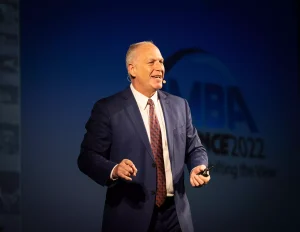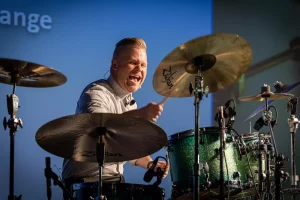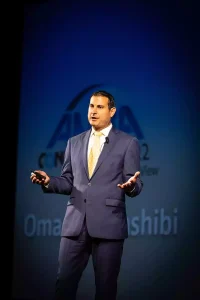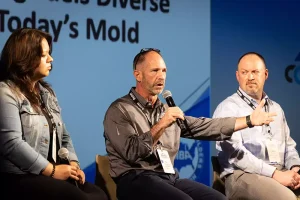
As the ballroom lights dimmed and spotlights illuminated the stage at the Westin Chicago Northwest in Itasca, Illinois, AMBA Executive Director Troy Nix took the stage to welcome more than 150 AMBA members and guests to this year’s national conference, held on
May 11-13.

While recent months have seen the mold manufacturing industry dealing with systemic challenges like supply chain disruptions, labor shortages, stagnant or shrinking profits and, unfortunately, the ongoing COVID-19 pandemic’s effect on how they conduct business, Nix reminded attendees that this conference provides one very good opportunity to connect, share, and explore new and better ways to manage and overcome the obstacles they face every day.
For the next two days, attendees were asked to “Shift the View,” and explore how day-to-day business can be performed differently to bring about positive changes within their companies and within the industry. “With a new lens, who knows what possibilities the future may hold?”
Clint Pulver
Emmy Award-winning speaker Clint Pulver opened his keynote by asking attendees, “How do people experience you?” At first the question seemed trite, but Pulver had a few surprises up his sleeve that snapped his audience to attention. As a kid, Pulver often tapped his hands. He could not stop. He tried, but the
twitching helped him focus. Then one day a teacher, Mr. Jensen, took him aside after class and offered him hope, saying, “I have been watching you in class. You know, I don’t think you’re a problem. I think you are a drummer.” Pulver was that little boy.

Pulver told attendees that he is someone who believes in iconic moments. “A single moment has the ability to change somebody’s life – writing a better story,” he said. Mr. Jensen presented Pulver with his first set of drumsticks. “Everybody saw the problem, but one person in my life saw it as an opportunity.” He emphasized to the AMBA attendees that they can apply Mr. Jensen’s viewpoint to their employees’ success. He said effective leadership requires both mentorship and respect, both of which hold an elevated level of standards and connection. “No significant loyalty (from employees) will ever happen without significant connection,” he said.
Jeremiah Sinks
Keynote speaker Jeremiah Sinks is a workforce development specialist with the Purdue University Manufacturing Extension Partnership. During the conference, he coached attendees to think and act less like a “boss” and more like a leader. “A boss builds a toxic culture,” he said. “A leader gets the willing participation of people to follow. Leaders build people and history. In turn, what the people build is your legacy as a leader.”
Sinks shared what he calls The Four Cs of Employee Success: Compliance, Clarification, Culture, and Connection. For an employee to embody these core values, the leader must create a sense of value and belonging in that person. “Your culture comes from you,” he said. “A sense of community and well-being is valued more than the company brand.” While upskilling employees is a core responsibility of the leader, it is also important to build employee engagement, which requires Connection, Ownership and Purpose.
Alyson Van Hooser
Keynote speaker Alyson Van Hooser did not grow up in the lap of luxury. She had to work hard at not just surviving but changing her perspective on her future life. She didn’t have a lot, but she did learn to shift her perspective to attain a more positive and motivated mindset. She found positive ways to overcome her life’s challenges and build a better life story.

From her story, attendees learned how building more authentic connections with their employees is the pathway to solidifying the foundation for team success. Employers are dealing with many challenges every day, and in many cases, they have several generations of employees that need to find ways to work successfully together. Van Hooser said that by understanding each employee’s story – not statistically but authentically – a leader will begin to sow the seeds of empowerment, ownership and accountability, growing the company’s culture into one that motivates and drives its workforce.
“I believe that organizations that are going to be successful for the next two, five, ten years will be organizations that begin to create leaders at every level,” she said. “Leadership is not position. Titles don’t mean much these days. What impresses people is the experience that you have, the difference that you’ve made, and how you have impacted other people. Leadership means that we no longer see generations. We no longer see labels. Instead, we see people who have stories.” She adds that leaders are focused on the needs of their people to belong, to grow in their role and to contribute to the organization. They must also act. “It’s easy to lead a workforce based on what other people say, the statistics they put out. Leaders don’t rest on statistics; they serve the needs of their people.”
Omar Nashashibi

Omar Nashashibi of The Franklin Partnership, AMBA’s lobbying firm in Washington D.C., reported on the latest progress and some possible setbacks regarding policymaking, trade with China, tariffs, the election and manufacturing jobs during the Grand Ballroom session. He said that the number of manufacturing bills being proposed in congress has more than doubled, showing a lot of activity affecting domestic manufacturing. He noted that one major problem concerns semiconductors because the US does not make enough. “China spends almost three times what the USA spends just on semiconductor manufacturing,” he said.
Nashashibi also touched on the ever-present topic of tariffs, telling attendees that about 7,000 products being shipped to the US are currently subject to 25% tariffs and about 3,000 products are subject to 7.5% tariffs. Of course, there are legislators in Washington who seek to eliminate them, so AMBA members must make their
case sooner than later.
Perspectives on additive manufacturing
 Additive manufacturing, whether plastic or metal, is consistently finding its way into more and more mold manufacturing companies. At the conference, Scott Kraemer of Mantle Inc. moderated a session with panelists Ray Coombs of Westminster Tool, Amanda Wiriya of Wepco Plastics, and Mike McLean of Byrne Tool & Design, to give attendees some perspective on the technology, good and bad.
Additive manufacturing, whether plastic or metal, is consistently finding its way into more and more mold manufacturing companies. At the conference, Scott Kraemer of Mantle Inc. moderated a session with panelists Ray Coombs of Westminster Tool, Amanda Wiriya of Wepco Plastics, and Mike McLean of Byrne Tool & Design, to give attendees some perspective on the technology, good and bad.
Wiriya shared that a big challenge was integrating plastic AM with the Wepco team when they first started working with the technology for medical prototypes four or five years ago. “We’re injection molders and our parts looked better,” she said. “Sometimes they are almost faster than what you can get out of a 3D printer even including the tooling side, but we said let’s take that journey. Maybe the technology isn’t there yet, but let’s make sure that when it is there, we’re not the last ones to learn about it. Let’s start that learning process so that when it’s ready for us, we’re ready for it.”
Byrne Tool first began working with 3D printing in 2010 to create prototypes for its sister company. McLean shared the company’s journey from using additive manufacturing to print prototype parts so customers could test form, fit and function, then using it to print fixtures for the parts, and then expanding its use not only for customers but also for other shops who were interested in trying it out.
All three companies see AM as not just an
entrepreneurial endeavor to attract new business, but as an investment in their future.
Peer-to-Peer Exchanges
Probably one of the most popular parts of the
AMBA Conference is the chance to attend one of Peer-to-Peer Roundtable Discussions during which attendees can ask questions and learn new ways to address challenges from colleagues who have had similar experiences.
This year, four roundtable topics were offered: Owners/Presidents/CEOs, Operations, Sales and Marketing, and Workforce Development.
Each discussion is monitored to keep everyone on track timewise, but the sessions never fail to fulfill the promise of walking away having learned at least one valuable idea or strategy for solving a problem, being a more effective leader, attracting new talent, and so on, from colleagues old and new.
The discussions are honest and often in-depth, with participants willing and able to share openly with each other.


